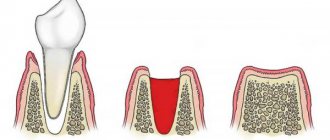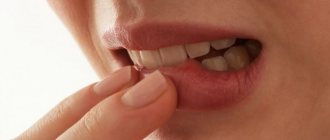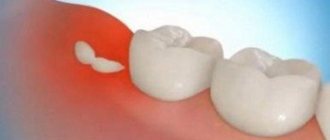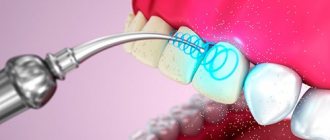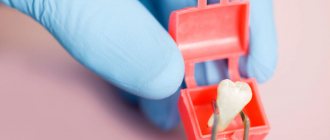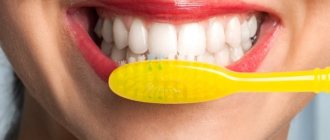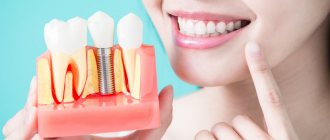13917
Denture implantation is a surgical procedure to insert a foreign object into the patient's jaw bone.
Like any surgical procedure, implantation is accompanied by some complications, such as pain and swelling.
Causes of swelling after implantation
The causes of swelling on the gum or cheek after dental implantation lie in physiology. Due to tissue injury, there is an influx of lymphatic fluid, which allows the operated area to regenerate (recover). Injuries during implantation are inevitable - after all, the dentist needs to make cuts or small holes in the gums, prepare a bed in the bone for the implants, then install them, and apply sutures if necessary. When removing diseased teeth/roots immediately before implantation, microtraumas also appear.
New teeth in 1 day - All-ON-4 - 280,000 rub.
All inclusive!
3D modeling of the structure with a prosthesis, implantation of 4 Nobel Biocare implants, installation of a fixed prosthesis on the same day. Free consultation with an implantologist +7 (495) 215-52-31 or write to us
Symptoms of complications
There is a list of very simple instructions for quickly relieving swelling:
- At the end of the operation, it is necessary to apply cold to the site of future localization of edema. The clinic staff will take care of this.
- Over the next day and a half, you must continue to apply cold periodically. Ideally, this should be done every half hour and kept for at least 15 minutes. In reality, not many patients do this.
- After surgery, the doctor usually treats the wound site with a special dental paste, which speeds up the healing process. He will prescribe the same ointment for further use.
- Try to stay in an upright position for a longer time - stand, sit. Lie down as little as possible. When sleeping, you need to hold your head higher, for example, on a high pillow. These measures increase blood flow from the head, thereby reducing swelling.
- To speed up wound healing, it is necessary to rinse your mouth every time after eating with a special antiseptic solution prescribed by your doctor and use dental paste several times a day. It is important to prevent infectious inflammation.
- The diet should be changed in favor of soft and liquid foods. It is advisable to avoid any nuts or meat either.
Swelling will appear in two to three hours. Pain will appear along with the swelling (the anesthesia will wear off). The pain is relieved with a painkiller prescribed by the doctor (for example, nimesil) and you can practically forget about the pain.
If the implantation operation is successful and there is no inflammatory process afterwards, the swelling will persist for 6-10 days. The period depends on the individual characteristics of the body and on the patient’s compliance with the above recommendations.
It is also important to monitor the dynamics of the reduction of the swollen area. Under normal circumstances, peak swelling is reached on the 3rd day. Then the swelling should gradually subside.
dentaliga.ru
- After eating, the mouth should be rinsed with antiseptic solutions.
- Treating seams with a special paste.
- Teeth that are close to the sore spot should be cleaned with cotton swabs and hydrogen peroxide.
- Care for other teeth using traditional methods.
- Chamomile infusions are good for reducing swelling. This plant has remarkable restorative and antimicrobial properties. You can rinse your mouth with this decoction a day after the operation.
During the first 2-3 hours after installation of the artificial structure, a slight swelling appears on the gum and cheek area. It will not last a single day, since the process of restoration of damaged tissue can last about a week. There will be swelling all this time. An important day that can turn the tide in the development of possible inflammation is the third day after surgery.
There is no clear answer to the question of how long the swelling of the gums or cheeks will last after implantation. It is necessary to strictly follow all doctor’s prescriptions to reduce pain.
- One of the primary recommendations is to apply cold to the site of the installed implant. This can be a regular ice pack, which should be kept for about 30 minutes. Apply the compress several times daily and the existing swelling will significantly decrease. It is recommended to carry out the procedure for the first two days, then take a break.
- It is extremely important to maintain good oral hygiene. After each meal, rinse your mouth with antiseptic solutions.
- Painful sensations are relieved by prescribing appropriate medications. To relieve or prevent inflammation, a course of antibiotics is prescribed. In some cases, additional vitamins or agents to enhance immunity may be prescribed.
- Review your diet. Focus on warm and soft dishes. Eat on the side that is not damaged.
- Take your dentist's advice to sleep on a high pillow. This will promote blood flow away from the surgical site and help reduce swelling after sleep.
- Give up bad habits such as smoking and alcohol abuse.
If you follow these recommendations, the swelling will go away faster. If suddenly, after a certain time, the swelling does not decrease, lasts longer than the doctor warned, and there is an increase in temperature, then this indicates an inflammatory process. In this situation, you must immediately contact a specialist.
DETAILS: Dental implantation in elderly patients. Features of this technique and indications.
myimplants.ru
What determines the size of the edema?
The amount of facial swelling after dental implantation can vary significantly - for some, the cheek “inflates” as if water had been taken into the mouth, while for others there may be no swelling at all. In general, the size of the jaw swelling after implantation, and how long it lasts, depends on the following factors:
- skill of a dentist-implantologist: modern doctors practice 3D implantation planning. Before the operation, a special program based on computed tomography of the patient’s jaw selects the optimal models of implants and their placement locations, taking into account the density and volume of the bone, the location of large vessels and nerves. Next, individual templates are printed that will allow the implants to be installed in reality exactly in accordance with the plan and with minimal tissue trauma. That is, the level of injury is significantly reduced,
- quantity, size and quality of implants - the more installed, the higher the likelihood of swelling,
- method of implant installation: minimal swelling, as a rule, occurs after “bloodless” (or minimally invasive) implantation. More extensive - after a patchwork (when incisions are made in the gums and sutures are placed), after simultaneous replantation of a bone block, after a sinus lift in the area of the lateral upper teeth (raising the bottom of the maxillary sinus),
- individual characteristics of the patient’s body: age, presence or absence of chronic pathologies, tolerance to medications (prescribed after dental restoration). In particular, edema often occurs in the presence of problems with the cardiovascular system,
- compliance with postoperative rules (more on this below).
Why does swelling occur after dental implantation?
In general, swelling is a completely normal reaction of the body to injuries. All this is nothing more than an influx of lymph to damaged tissues (i.e., accumulation of fluid in a certain area). This way the body’s natural defenses are activated. Swelling forms within 2-3 days - it reaches its peak on the third day after surgery. After this, the swelling of the tissues should gradually decrease and disappear completely within a week.
When installing classic two-piece implants, when the flap method with gum peeling is used, the likelihood of tissue swelling is much higher. Patients with pathologies of the cardiovascular system and diabetes mellitus are also at risk.
How long does swelling last normally and how quickly can it go away?
How many days does swelling last after dental implantation? Here it is worth starting with the fact that immediately after installation of implants there is no swelling or it is mild. But after 12-24 hours, swelling can noticeably increase in size - this is clearly visible in the photo. Maximum swelling is observed 2-3 days after implantation. And this is absolutely normal. How long the swelling lasts depends on the physiology of the individual patient. Usually, 3-4 days after the installation of implants, swelling begins to subside (on average, noticeable swelling lasts 24-36 hours), and after 7 days it is practically not noticeable from the outside.
Swelling after implantation - normal or pathological
Swelling after the installation of a dental implant in the area of the operated gum usually appears several hours after the operation itself. The swelling may increase depending on the number of implants used, as well as the individual characteristics (reactions) of the patient’s body. An acceptable degree of complication is when the face and lips become swollen during the first hours after surgery.
An increase in the degree of pain and swelling itself is allowed only during the first three days after the operation.
In the absence of any complications or problems, on the fourth day the patient should feel noticeably lighter and more comfortable. This applies to eliminating pain, as well as reducing the degree of swelling. As a rule, the process of restoring full functionality takes no more than 6-7 days after surgery.
The reason for immediately seeking medical help is increasing pain and swelling of the gums after the first three days. The patient's further actions can only be determined by the doctor after a thorough examination. Elevated body temperature (within 37.2 degrees) is acceptable only on the first day of the patient’s recovery.
Ways to reduce swelling
What to do to reduce or relieve swelling after implantation? The first “home” remedy is cold compresses. But ice should be used correctly to avoid frostbite or tissue necrosis. What can be done? When you return home after having your implants installed, remove ice, a bag of frozen vegetables/berries, or meat from the freezer. Wrap the ice in a bag and wrap it in several layers of thin cloth (gauze) or wrap it in a terry towel. Apply the cold to your cheek for 5-10 minutes (do not put pressure on your cheek or jaw!), then take a break for 7-10 minutes. Compresses can be repeated for 1.5-2 hours. On the first day after implantation, you can do 2-3 such “cooling” approaches.
What you should never do is apply hot compresses. Because increased temperature increases blood flow to the surgical site, which can lead to increased swelling and increases the risk of inflammation. As a result, recovery will be slower, swelling will persist longer, but the most dangerous thing here is the risk of peri-implantitis and implant rejection.
How to reduce swelling
In order not to provoke an increase in the tumor, you must strictly adhere to the rules of the rehabilitation period: do not touch the mucous tissue near the pin with your hands, do not eat on this side, do not drink alcoholic beverages, do not smoke.
Actions aimed at reducing swelling begin in the first hours after the end of the operation. The simplest and most effective method is this: a cold heating pad, ice or frozen vegetables are wrapped in a towel and applied to the cheek, chin or under the nose (depending on where the dental implantation was performed). The cold is kept for a short time - 5-10 minutes, after which they take a break of approximately 10-15 minutes. In this mode, the face is cooled for a couple of hours, and then the intensity is reduced.
This is a very effective method, but it should be used in moderation, without trying to improve the situation with prolonged cold applications. Excessive zeal can lead to frostbite of the skin, especially if its sensitivity has not yet recovered after anesthesia, or cause necrosis.
To prevent swelling from increasing, you need to remove all solid foods from your diet, as well as bitter, sour, cold and hot foods. Strong coffee is also prohibited.
There are a few more tips to help reduce the intensity of swelling. The first concerns sleep position. In order not to impair the flow of blood and lymph from the head, for two to three days you need to sleep in an almost semi-sitting position, placing a high pillow or several pillows under your head. Under no circumstances should you lie down on the side on which the implantation was performed.
During the first week, going to baths, saunas or swimming pools is strictly prohibited. These activities can not only cause increased swelling, but also lead to bleeding. It is best to bathe in a warm shower.
To reduce swelling, your doctor may prescribe decongestants and antihistamines. They are selected individually, based on the patient’s health characteristics. On the third day, the implantologist schedules the first follow-up examination, during which he will assess the person’s condition, the progress of healing and the severity of swelling. If doubts about the normal course of rehabilitation have appeared before this point, you can come for a consultation earlier.
Tips to reduce discomfort
General recommendations for speedy rehabilitation are as follows:
- tune in to recovery (recovery): watch your favorite movies, listen to music, read optimistic books,
- provide yourself with comfortable conditions at home in advance: buy medicine (more on this in the next section), cook light broth, stock up on pureed food - cottage cheese, yoghurt, you can buy baby food in jars. There should also be a large bottle of clean warm water at home,
- do not overload the body, let all efforts be directed towards regeneration: you can take 3-4 days off from work, do not lift weights, do not play sports, do not take hot baths. Visiting baths, saunas, swimming pools and air travel should also be avoided at first,
- Perform oral baths as prescribed by your dentist: do not rinse, as infection may get into the wound,
- Brush your remaining teeth very carefully, but with a new brush (there are definitely germs on the old one),
- try to chew food on the non-operated side of the row,
- do not suck out the puree and liquid from the tube, it is better to use a spoon: low pressure in the oral cavity can lead to movement of sutures, membranes,
- give up coffee, cigarettes and alcohol (at least at first): there are many reasons for this - drying out the mucous membranes in the oral cavity, overheating of tissues, increased blood pressure, toxic effects. As a result, rehabilitation and engraftment of implants are slower,
- Take all prescribed medications according to the regimen received from your doctor.
What complications can occur during dental implantation?
Some complications during dental implantation may also arise in the process of further prosthetics.
- overheating of the implant during the preparation of its head
- incorrect installation of the implant head
- incorrect installation of dentures
In this case, complications are most often the result of low qualifications of the doctor. An experienced dentist practically does not allow such complications.
It should also be remembered that complications can arise long after surgery and installation of prostheses. These are the so-called complications during the functioning of the implants.
These include inflammation of the gum tissue around the implant, peri-implantitis, mechanical damage to implants and dentures installed on them, and implant mobility.
The most common causes of such complications are:
- incorrect installation of implant components
- unsatisfactory oral hygiene leading to disruption of the protective function of the gingival cuff
- the presence of cement residues deep in the gingival cuff
- chronic injury to the gingival cuff
- strong mechanical stress on the prosthesis and implant components during chewing
Installation of implants can be complicated by a number of consequences. Complications may arise due to:
- Medical errors: incompetence of the doctor, incorrect selection of the length of the implant, overheating of tissues during the formation of the hole for the implant, infection, errors in the positioning of the structure, peculiarities of the patient’s physiology, individual intolerance to the implant materials.
- The use of low-quality implants and outdated equipment. A possible disadvantage of the implant may be a poor connection to the abutment.
- Patient's fault. Most often, failure to maintain sufficient hygiene. The area where the crown touches the gum is especially susceptible to the accumulation of tartar, which causes inflammation. Complications can be caused by failure to follow recommendations for taking medications and lifestyle.
Complications can arise due to medical errors and the fault of the patient
Negative consequences of dental implantation can occur in:
- in the short term - before prosthetics;
- medium-term - within two years after implantation;
- long-term - after two years from the moment of implantation.
Implantation may be accompanied by complications that arise during the operation. Highlight:
- Heating the implant during preparation of its head. To eliminate the problem, the doctor must irrigate the preparation area and the bur.
- Incorrect implant installation. A common mistake is tightening the screws when installing an implant while the cement is hardening. This is fraught with cracking of the cement when twisted.
- Incorrect installation of the implant head. If the connection of the implant head with the intraosseous element is not tight, an accumulation of microbes, tissue fluid and overload of other structural supports occurs, which threatens peri-implantitis.
On the upper jaw
Carrying out implantation in the upper jaw is accompanied by a number of difficulties and complications. This is due to the structure of the jaws and the inaccessibility of the required areas. Implantation in the upper jaw extends from nearby important organs.
Long implants are required for installation strength, which often cause the following complications:
- the nasopalatine bundle, located in the center, behind the incisors, is injured, bleeding occurs and the implant does not integrate into the bone;
- can damage the bottom of the nasal cavities, a possible complication is perforation of the internal nasal mucosa, infection in the apical (lowest point of the rod) part of the implant;
- the neurovascular bundles located in the canine area are damaged, numbness of the upper lip is observed;
- pierce the bottom of the sinus, which provokes the development of sinusitis;
- damage the palatal artery in the area of the palatine-maxillary mass, bleeding occurs.
The upper jaw has less density, so elongated implant models are required, which can cause complications
In the bottom row
The lower jaw has areas, damage to which is fraught with negative consequences:
- loss of sensitivity is caused by compression or rupture of the mandibular ramotigeminal nerve;
- numbness of the lower lip, tissues around and the lateral part of the lower jaw occurs due to damage to the wall of the mandibular canal;
- damage to the external branch of the facial artery requires urgent assistance from a surgeon;
- buccal perforation exposes the implant thread.
What medications are there for swelling?
How to relieve swelling after dental implantation? To relieve swelling, dentists prescribe antihistamines, for example, the drugs Suprastin, Zodak, Loratadine. Depending on the strength of the active substance and the patient’s health condition, decongestants can be prescribed 1-3 times a day, during meals. The course is approximately 5 days.
Read on: useful recommendations for eating and lifestyle immediately after dental implantation.
In addition to eliminating swelling, antihistamines reduce the side effects of antibiotics (which are often prescribed for dental implants). But it is better to give preference to the latest generation drugs, because Early generation antihistamines often cause drowsiness. But, in principle, this drawback can benefit patients with insomnia - after all, the body recovers faster during sleep.
“After installing the implants, I was prescribed three medications at once - antibiotics, for swelling and for pain. They said that the swelling could also be due to slight inflammation, because many implants were implanted at once. And all these medications will help you return to normal life faster. But, to be honest, I didn’t notice much swelling in myself, maybe my cheek puffed up just a little.”
Irina Vladimirovna, 51 years old, review from otzovik.com
Treatment
The use of modern drugs for the treatment of pathological swelling gives good results.
Chlorhexidine
Antiseptic liquid with a concentration of chlorhexidine digluconate 0.05% and excipients. Active rinsing is carried out three days after surgery. Before this, the liquid is taken into the mouth, held for several minutes, and then spat out.
15 ml of solution is enough for one rinse. Use the drug up to 4 times a day for 5 days. The product has disinfecting properties and destroys all microflora, and also promotes the development of a blood clot in the damaged socket.
Betadine
10% antiseptic liquid is used to relieve inflammatory processes and destroy pathogenic microflora. The substance is diluted in the proportion of 3 drops per 100 grams of water.
In the first days after surgery, rinse the mouth with the drug up to 6 times in 24 hours. However, the procedure should not be overly active.
In the future, four rinses a day will be enough. Helps in the restoration of damaged tissues, forms a protective shell that prevents the development of fungi, bacteria and infections.
Amoxiclav
A semi-synthetic antibacterial drug that contains amoxicillin and clavulanic acid.
The first destroys bacteria, and the second stops their enzymatic action. Used in the amount of 1000 active units twice a day.
The drug helps relieve inflammation and rapid healing of the operated surface.
Dexalgin
A non-steroidal anti-inflammatory drug belonging to the group of analgesics. It contains the active substance dexketoprofen trometamol, the effect of which lasts 3-6 hours after administration.
Take 1 tablet three times a day with an interval of 8 hours. Not recommended for long-term use. The optimal time frame is 3-5 days. Relieves swelling, normalizes body temperature, relieves pain.
What is the sinus lift technique, and for what purpose is the operation performed before implantation.
In this article we will talk about the stages of installing a healing abutment.
Here https://www.vash-dentist.ru/implantatsiya/metodiki/otzyivyi-vred-protivopokazaniya.html you will find reviews about installing dental implants.
Nurofen
Non-steroidal anti-inflammatory drug with the active substance ibuprofen. It begins to affect the body within 20 minutes after application.
Prescribed after implantation for acute pain, fever and inflammation. Take 1 tablet no more than 4 times a day.
Helps relieve pain , promotes rapid healing and normalizes body temperature.
Nimesil
It contains the active substance nimesulide, which has the ability to anesthetize and relieve inflammation in the damaged area.
In dental practice, Nimesil is used in powder form. One package of the drug is required for one dose, the effect on the body is felt 20 minutes after administration, the next use should be no earlier than 12 hours later.
Nimesil relieves pain, normalizes body temperature and relieves inflammation in tissues.
When to see a dentist for help
It has already been said above how facial swelling develops normally, and how many days after dental implantation it should go away. Now let's focus on pathological conditions - after all, you need to be able to distinguish the norm from complications[1], which require medical attention:
- the swelling is very large, the skin of the cheek is red,
- the swelling has not decreased in size 4-5 days after surgery,
- the swelling subsided, and a few days later it appeared again,
- bleeding from the wound does not stop or intensifies,
- pus appeared from wounds, from under dentures or putrid odor from the mouth,
- the temperature does not decrease for more than 3 days or suddenly “jumped” after normalization of the condition,
- noticeable numbness of the cheek or tongue does not go away 2-3 days after surgery,
- The stitches on the gum have come apart.
Innovation! Implantation WITHOUT bone tissue augmentation.
A method of dental restoration in which implants are installed in deeper bone areas that are less susceptible to atrophy. Find out more >> Consultation with a doctor is free! Call now: +7 (495) 215-52-31
Associated complications
Temporary swelling is a normal reaction of the human body to surgery. It is important to take into account that the presence of edema may indicate the development of dangerous postoperative complications, which in medical practice are usually divided into two main groups: early and late.
| Complications group | Description and characteristics |
| Early complications | Bruises and hematomas. |
| Inflammation of soft tissues in places of direct damage. | |
| Seams coming apart. | |
| Constant and increasing pain in the operated area of the gum. | |
| Late complications | Rejection or mechanical damage to the implant, which is typical not only during the stage of engraftment of a foreign object, but after it. This is possible as a result of a burn, improper installation of an implant, or after infection of open wounds. In such cases, the artificial tooth must be removed. |
Peri-implantitis, which is a consequence of poor oral hygiene, which provokes infection.
As treatment, the patient is prescribed surgery to remove pustular lesions in the oral cavity, as well as taking antibiotics (with individual selection of the drug and its dosage) and regular rinsing of the mouth with antiseptic solutions. | |
| Inflammation of the maxillary sinuses, which is important for operations on the upper jaw. |
The listed early complications are classified as standard and, as a rule, go away on their own or are easily eliminated by the dentist. In any case, the help of a doctor is necessary, as well as scrupulous compliance with all instructions on the part of the patient himself. This requirement is due not only to the desire to preserve the existing artificial tooth, but also to prevent more serious diseases of the oral cavity in the future.
Associated symptoms after implantation
Along with swelling after implantation, bleeding from wounds, numbness of the cheek, redness of the gums, hematoma on the cheek, pain in the jaw or head, increased body temperature up to 39 degrees, difficulty opening the mouth, weakness, and ringing in the head may be observed. These are also normal conditions, but they should also fade away every day, and not intensify.
[1] Garayev Z.I. Reducing the risk of complications of dental implantation, 2014.
Author: Gorovoy E. A. (Thank you for your help in writing the article and the information provided)
Recommendations for the patient
- After eating, the mouth should be rinsed with special antiseptic solutions.
- Treat seams with adhesive paste.
- Teeth located close to the surgical field must be treated with cotton swabs soaked in a solution of hydrogen peroxide (3%).
- Care for the rest of your teeth as usual.
- Decoctions of calendula and chamomile help reduce swelling and speed up healing. These plants have bactericidal, anti-inflammatory and regenerating effects. You can rinse with them only one day after surgery.
protezi-zubov.ru
To reduce swelling and speed up the healing process, it is imperative to apply ice to the implant site, especially if a sinus lift operation was performed (increasing bone volume for implantation).
In the postoperative period it is necessary:
- Use adhesive ointment for healing (as prescribed by a doctor);
- Treat teeth close to the implantation site with cotton swabs soaked in a 3% hydrogen peroxide solution;
- After each meal, rinse your mouth with antiseptic preparations;
- Take food only at room temperature, crushed in a blender;
- To relieve unpleasant, uncomfortable sensations, you can take painkillers once a day;
- It is recommended to brush your teeth with a new, soft toothbrush, the bristles of which have a natural base.
Swelling after dental implantation is an absolutely natural condition. But if after 4-5 days your health worsens and your symptoms intensify, you should consult your doctor. If you follow all the recommendations for caring for the oral cavity after implantation, the swelling will completely disappear after 7 days.
otekimed.ru
- Use adhesive ointment for healing (as prescribed by a doctor);
- Treat teeth close to the implantation site with cotton swabs soaked in a 3% hydrogen peroxide solution;
- After each meal, rinse your mouth with antiseptic preparations;
- Take food only at room temperature, crushed in a blender;
- To relieve unpleasant, uncomfortable sensations, you can take painkillers once a day;
- It is recommended to brush your teeth with a new, soft toothbrush, the bristles of which have a natural base.
To avoid complications and speed up the healing of the jaw, you should follow the doctor’s recommendations and prescriptions. Patients in the postoperative period are recommended the following:
- Carry out hygienic care thoroughly;
- Rinse your mouth 6-8 times a day;
- After eating, rinse your mouth with antiseptics;
- Apply medicinal ointment to the stitches;
- Do not eat spicy, salty, hot foods;
- Avoid physical activity.
The patient is recommended to carry out the following procedures:
- Perform thorough but gentle oral hygiene.
- Carry out oral baths with antiseptic solutions and decoctions of medicinal herbs.
- Appliqués should be applied to the seams.
Minimizing complications
Gum inflammation after implantation depends on many factors. One of the most important is the poor quality of implants. Therefore, you should be careful about their choice. After your doctor gives you options, make sure the implant meets the following requirements:
- the titanium from which it is made has a high degree of purity;
- the design has both micro-thread and macro-thread;
- the implant and abutment are fixed with a conical connection (this is not necessary, but such a connection is considered the most reliable today);
- your future tooth comes with a long, or better yet, lifetime warranty - this is not only a pleasant addition, but also a sign that the manufacturer is confident in its product;
- choose products from companies that have been on the market for a long time and are known to specialists; consult an independent dentist about this.
Do not skimp on the system, as in the future, a bad implant can lead to serious complications, which will be much more expensive to eliminate. Of course, even with high-quality products, the body will try to fight, but nothing serious will most likely await you.
Difficulties of the early postoperative period (before prosthetics)The most common problem in the early postoperative period is hematomas of varying volume and location. Unfortunately, it is impossible to guarantee that hematomas can be avoided. For prevention, you can use the proven method of local cold and (or) a pressure bandage. To speed up resorption, we apply Troxevasin→ or Actovegin→.
It is best to warn the patient during the conversation before surgery about “possible slight bruising” and some soreness in the first couple of days. If this does not happen, then thank God! And if anything, then you gave fair warning. Just don't overdo it and don't thicken the paint.
It happens that on days 3–7 after surgery, swelling and tension occur along one of the flaps that are folded back during the operation with the development of a purulent process. In all clinical manifestations, this resembles banal periostitis. Moreover, in 9 out of 10 cases the process occurs in the lower jaw. Reflecting on the reason, I came to the conclusion that this is probably due to the following circumstances: the surgeon is traditionally positioned to the right of the chair, and the nurse, accordingly, to the left, and throughout the operation holds the aspirator in one hand and the retractor hook in the other.
Therefore, under the flap, where there is no active aspiration, fragments of bone chips, epithelium, etc. settle purely mechanically, which, given a certain bacterial and immune background, creates a wonderful environment for the development of suppuration, and if your sister (assistant) is right-handed and is located behind The patient, as a rule, holds the aspirator in his right hand, and the retractor hook in his left. Because of this, in the third quadrant the saliva ejector is located under the lingual flap, and in the fourth quadrant - under the buccal flap.
Consequently, the inflammatory process, on the contrary, occurs in the third quadrant under the buccal flap, and in the fourth - under the lingual flap. Therefore, before suturing the wound, carefully, with a strong stream of saline, we wash all the spaces under both flaps with simultaneous aspiration!
4.5.-1 Hematoma after implantation surgery in the area of 32, 31, 41 and 42 teeth.
4.5.-2 Hematoma of the upper and lower eyelid and nasolabial fold after surgery in the area of the 23rd tooth.
4.5.-3 From time to time you have to deal with the formation of small, clearly defined purulent pustules that appear directly above the implant. If you pass through such a pustule with a probe or a small excavator and rest against the implant plug, you can see that the implant is motionless and painless when you try to rock it. It is better to excise the pustule.
ABOUT ANTIBIOTICOPROPHYLAXIS
Here it is appropriate to remember that one of the main tasks remains the prevention of infectious and inflammatory processes in the surgical wound, the development of which can negate all our efforts. It is known that preventing complications is much simpler and safer than combating a developed process. Traditionally, antibacterial drugs and antiseptics are used for these purposes, but we must not forget about such prevention methods as: reducing the operating time, fighting nosocomial infections, observing the principles of asepsis, equipping the operating room with bactericidal lamps with forced and constant air circulation, etc.
It is also necessary to take into account the technique of preparing the bone bed for the implant (using a sharp instrument with an optimal shape to remove heat and chips, adequate cooling, adherence to the preparation regime, etc.). It is known that more than 30% of antibiotic prescriptions are for the purpose of prevention.
Properly planned antibiotic prophylaxis reduces the rate of complications several times. One of the main factors influencing the development of wound infection is the degree of microbial contamination.
Depending on this, implantological procedures are divided into 4 groups:
- clean operations (risk less than 5%) - operations performed without additional soft tissue incisions using mucotomes and lasting up to 20 minutes (antibiotics, in principle, are not needed);
- conditionally clean (risk about 10%) - low-traumatic operations associated with long-term exposure of the wound, a large surgical field and duration up to 40 minutes (antibiotics are prescribed 1-2 hours before surgery and 3 days after);
- contaminated (risk about 20%) – implantation immediately after tooth extraction, all types of augmentation, duration more than 40 minutes (antibiotics are prescribed 1–2 hours before surgery and 5 days after);
- dirty (risk about 30–40%) - operations in obviously infected areas, installation of implants immediately after tooth extraction due to a chronic infectious-inflammatory process, raising the bottom of the maxillary sinus during a chronic inflammatory process in the sinus, augmentation using extraoral donor sites, etc. d. (antibiotics are prescribed for a period of up to 7 days and, if necessary, extended to 10).
When planning antibiotic prophylaxis, the following rules must be taken into account:
- administration of antibiotics should begin 1–2 hours before surgery (depending on the drugs used);
- the half-life of the antibiotic should exceed the duration of the operation;
- if the wound is widely connected to the oral cavity, and there are additional risk factors, then antibiotic therapy continues for up to 7 days in combination with antihistamines.
Of course, the choice of specific drugs and their dosage is a very individual matter. But in my practice, amoxiclav 625 mg has proven itself well (first dose: two tablets 2 hours before surgery plus one tablet before bedtime. Then take 1 tablet 2 times a day (for prevention - 3 days, with the threat of possible complications - 5 -7 days). A good result is obtained by using Avelox→ 0.4, one tablet for 5 days. In the oral cavity, as a rule, a combination with protozoa is found, so in the postoperative period it can be recommended to brush your teeth with Metrogil-Dent ointment→, which is applied use a toothbrush instead of toothpaste, and don’t rinse your mouth out after brushing!
In addition, it is good to prescribe non-steroidal anti-inflammatory drugs (ibuprofen→, xefocam→, etc.) as a supplement. In patients with severe postoperative pain, indomethacin→ (also known as methindole retard 75 mg) once a day for 3–5 days after surgery gives an excellent result, which, being one of the most active non-steroidal anti-inflammatory drugs, has a pronounced analgesic effect.
Removable, temporary and immediate prostheses located directly above the area of the operation can pose major problems. If this is a temporary prosthesis fixed to adjacent teeth, then try to provide at least a minimal washing area so that the prosthesis does not put pressure on the mucous membrane above the installed implants. If this is a removable denture, try to ensure minimal pressure from the denture base over the implantation area by grinding off excess plastic.
4.5.-4 Wearing a removable denture after surgery and its pressure on the mucous membrane directly above the implants led to their unwanted eruption. This can complicate the aesthetic aspects of prosthetics. The most successful option is a design that is fixed to adjacent teeth (of course, if they exist) using all kinds of metal or fiber splints. In this case, the structure itself can adhere, but not be pressed into the mucous membrane 4.5-4a, 4.5-4b.
4.5.-4a
4.5.-4b
4.5.-6a After cystectomy with resection of the root apex, retrograde filling was performed with amalgam. A year later, the implant was installed. Due to the difference in electrical potential, amalgam fragments began to migrate to the surface of the implant and caused its rejection.
4.5.-6b The inflammatory process continued, despite the measures taken. After removal of the resected tooth, all phenomena completely ceased after five days.
Pay great attention to the condition of the teeth directly adjacent to the surgical site. If there is even a slight doubt about their viability, then endodontic treatment must be carried out before surgery. And be sure to take a control photo.
Odontogenic and radicular cysts pose a great danger, especially if the implant is installed in close proximity. The implantation operation itself can provoke increased growth of these formations. If it is planned to perform resection of the root apex of such teeth, then retrograde filling must be carried out with a composite material and in no case should amalgam be used for these purposes.
In addition, do not forget that titanium implants in the presence of an electrolyte (saliva) and metals (crowns, fillings, fragments of prostheses) can have a different electrical potential, which not only contributes to the accelerated formation of bacterial plaque, but also causes electrochemical corrosion.
Look at the clinical case presented on this page. The potential that arose between the amalgam and the titanium implant caused migration of the filling elements and, as a result, rejection of the implant.
4.5.-7 Filling material in the bone that does not bother the patient after implantation may cause pain.
4.5.-8 2 years after prosthetics on implant 22, the composite restoration on tooth 21 chipped. The tooth was depulped and a new restoration was made. A year later, tooth 21 began to hurt. This is a control shot.
4.5.-9 Always carefully assess the periodontal condition of the teeth adjacent to the implantation site.
4.5.-10 It’s hard to believe, but there are two identical implants in the picture.
4.5.-11a Looking at this picture, there is a feeling that the equator of the medial implant “crashed” into the 45th tooth, and even the root was damaged. In fact, these are ordinary projection distortions.
4.5.-11b Opening the implant to install the healing abutment. It is clearly visible that there is a distance between the equator of the implant and the 45th tooth.
4.5.-11c A gingival former is installed, the diameter of which is 2 mm larger than the equator of the implant. Even after this, the distance to the tooth is still maintained.
About the peculiarities of evaluating X-ray images
We all, of course, know that conventional (sighting and orthopantomographic) X-ray images almost always contain projection distortions, and very often these distortions are nonlinear and disproportionate in nature, making it difficult to interpret them correctly.
How many times have I encountered situations where a seemingly ideally installed implant (when assessed on an x-ray) turned out to be disintegrated and removed simply by hand, and at the same time, implants with an unfavorable x-ray picture were absolutely stable, painless and did not cause any complaints from patients .
In dental implantology, as nowhere else, it is categorically impossible to make a judgment only on an x-ray or only on examination of the oral cavity. It is imperative to evaluate both simultaneously.
Each doctor inevitably faces various problems and nuances in the course of his work. Therefore, do not hesitate to seek advice from more experienced colleagues.
